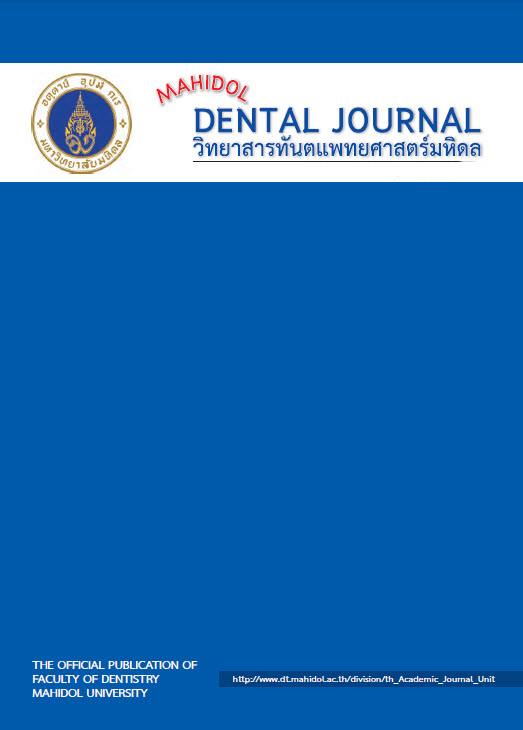Efficacy of a bleaching agent on fluorescence loss of enamel during orthodontic treatment by quantitative light-induced fluorescence
Main Article Content
Abstract
Objective: The purpose of this study was to evaluate the effect of a bleaching procedure containing 8% hydrogen peroxide on fluorescence loss of maxillary anterior teeth during orthodontic treatment.
Materials and Methods: Six maxillary anterior teeth of 19 patients were evaluated by using quantitative lightinduced fluorescence (QLF). The patients were divided into 2 groups according to the type of orthodontic bracket. Group 1: Orthodontic treatment with metal brackets and using bleaching agent during the last 10 days of orthodontic treatment. Group 2: Orthodontic treatment with ceramic brackets and using bleaching agent during the last 10 days of orthodontic treatment. QLF images were taken before and after orthodontic treatment. Four QLF parameters (ΔF, ΔFmax, A, and ΔQ) were assessed for six maxillary anterior teeth on the images.
Results: In metal bracket group, the QLF parameters revealed no significant changes except at the left maxillary lateral incisor (P < 0.05). In ceramic bracket group, the QLF parameters also revealed no significant changes except at the right maxillary lateral incisor, (P < 0.05). These two groups were reasonably similar with each other in terms of fluorescence loss.
Conclusions: The 8% hydrogen peroxide bleaching agent has no changes in fluorescence loss of maxillary
central incisors and canines. Therefore, it is suggested that no mineral loss when apply 8% hydrogen peroxide on maxillary central incisors and canines during fixed orthodontic treatment.
Article Details
References
Chatterjee R, Kleinberg I. Effect of orthodontic band placement on the chemical composition of human incisor tooth plaque. Arch Oral Biol 1979; 24: 97−100.
Korkmaz YN, Yagci A. Comparing the effects of three different fluoride-releasing agents on white spot lesion prevention in patients treated with full coverage rapid maxillary expanders. Clin Oral Investig 2019; 23: 3275−85.
Gomes MN, Dutra H, Morais A, et al. In-Office Bleaching During Orthodontic Treatment. J Esthet Restor Dent 2017; 29: 83–92.
Lunardi N, Correr AB, Rastelli AN, et al. Spectrophotometric evaluation of dental bleaching under orthodontic bracket in enamel and dentin. J Clin Exp Dent 2014; 6: e321–e326.
Consolaro A, Consolaro RB, Francischone L. Clarifications, guidelines and questions about the dental bleaching "associated" with orthodontic treatment. Dental Press J Orthod 2013; 18: 4–10.
Kwon SR, Wertz PW. Review of the Mechanism of Tooth Whitening. J Esthet Restor Dent 2015; 27: 240–257.
Haywood VB, Leech T, Heymann HO et al. Nightguard vital bleaching: effects on enamel surface texture and diffusion. Quintessence Int 1990; 21: 801–804.
Barghi N. Making a clinical decision for vital tooth bleaching: at-home or in-office?. Compend Contin Educ Dent 1998; 19: 831–840.
Jadad E, Montoya J, Arana G, et al. Spectrophotometric evaluation of color alterations with a new dental bleaching product in patients wearing orthodontic appliances. Am J Orthod Dentofacial Orthop 2011; 140: e43–e47.
Dietschi D, Rossier S, Krejci I. In vitro colorimetric evaluation of the efficacy of various bleaching methods and products. Quintessence Int 2006; 37: 515–526.
van der Veen MH, de Josselin de Jong E. Application of quantitative light-induced fluorescence for assessing early caries lesions. Monogr Oral Sci 2000; 17: 144–162.
Al-Khateeb S, Forsberg CM, de Josselin de Jong E, et al. A longitudinal laser fluorescence study of white spot lesions in orthodontic patients. Am J Orthod Dentofacial Orthop 1998; 113: 595–602.
van der Veen MH, Mattousch T, Boersma JG. Longitudinal development of caries lesions after orthodontic treatment evaluated by quantitative light-induced fluorescence. Am J Orthod Dentofacial Orthop 2007; 131: 223–228.
Lee JW, Lee ES, Kim BI. Can red fluorescence be useful in diagnostic decision making of residual dentin caries?. Photodiagnosis Photodyn Ther 2019; 26: 43–44.
Montenegro-Arana A, Arana-Gordillo LA, Farana D, et al. Randomized Double-blind Clinical Trial of Bleaching Products in Patients Wearing Orthodontic Devices. Oper Dent 2016; 41: 379–387.


